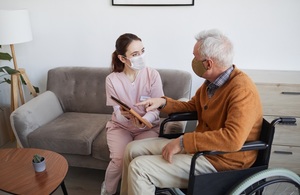Details of £500 million discharge fund
Details have been published of how the £500 million discharge fund will be given to help free up hospital pressures and reduce strain on NHS.

- Funding to speed up patient discharge, freeing up hospital beds to reduce ambulance handover times and improving capacity in social care
- Health and Social Care Secretary Steve Barclay addressed the NHS workforce at the NHS Providers annual conference
- He set out his key priorities including a focus on what matters most to patients, as well as putting the NHS on a more sustainable footing
Patients will benefit from faster access to emergency treatment following an injection of £500 million to free up hospital beds through quicker discharge, which will also help reduce ambulance handover times.
£300 million will be given to integrated care boards (ICBs) to improve bed capacity and £200 million for local authorities to bolster the social care workforce, increasing capacity to take on more patients from hospitals.
Local authorities and ICBs – organisations that bring the NHS together locally to improve health in the community – will work together to agree on spending across their regions, introducing tailored solutions which speed up discharge and benefit patients in their area.
Allocations will be published in due course with payments to be made in the coming weeks, following the announcement of the fund earlier this year. A second tranche of funding will be distributed in January 2023 delivering support across winter.
Speaking at the NHS Providers annual conference in Liverpool, the Health and Social Care Secretary said:
I am pleased to announce details of the fund which will be provided to ICBs and local authorities to free up beds, at a time when bed occupancy is at 94%.
In line with our devolved and data-driven approach we will be allowing local areas to determine how we can speed up the discharge of patients from hospital.
This might be through purchasing supportive technology boosting domiciliary care capacity or physiotherapists and occupational therapists to support recovery at home.
We will also be looking closely at the impact of how funding is used and using this data to inform future decisions around funding.
Local areas will be free to spend this money on initiatives which will have the greatest impact in their area on reducing discharges into social care, which in most areas will mean prioritising home care. Funding may also be used to boost adult social care workforce capacity, through staff recruitment and retention, where that will help reduce delayed discharges.
Addressing the workforce for the first time since returning to the role, the Health and Social Care Secretary set out his priorities today (Wednesday 16 November) for the coming months to ensure the health and care system continues to deliver for patients.
Key areas of focus for the months ahead will be:
- supporting the workforce including through more staff for NHS 111 and 999
- focusing on recovery plans across electives, urgent and emergency care
- tackling the issue of delayed hospital discharge
- improving access to primary care
- ensuring a stronger future for health including maintaining momentum on the new hospital programme and investing in technology to improve patient outcomes
Minister of State for Care Helen Whately said:
People should be cared for in the best place for them, but discharge delays mean patients are spending too long in hospital.
Our discharge fund will get more people cared for in the right place at the right time. We’re asking hospitals and the social care system to work together to help patients and carers too, who often take on a lot of the burden of caring when someone leaves hospital.
The discharge fund will boost the social care workforce and in turn reduce pressures on the NHS and hospital staff, as it frees up beds and helps improve ambulance handover delays.
On tackling the COVID-19 backlogs, the Health and Social Care Secretary emphasised the importance of close working between the Department of Health and Social Care and NHS England to reduce variation and tackle wider recovery challenges.
Looking beyond the immediate challenges of this winter, he reiterated the need to ensure a stronger future for health and care including investment in NHS buildings.
He set out his commitment to prioritise hospitals built using reinforced autoclaved aerated concrete (RAAC) as part of transformation plans as well as the need to modernise the way NHS buildings are constructed, moving away from bespoke designs by individual trusts and towards standardised designs that can streamline the approvals process and reduce construction time. This will help deliver new hospitals more quickly with better value for money, as part of the government’s commitment to deliver 40 new hospitals by 2030.
He also set out the need to harness the opportunities of new ways of working shown by the pandemic including use of the NHS app to reduce pressures in primary care. From the end of the month patients will be able to book their COVID-19 vaccine via the NHS app, reducing the burden on GP providers.
Closing his speech, he acknowledged the size of the collective challenge the system as a whole faces heading into winter and his commitment to working with the sector to build a more resilient, healthier NHS for the long term.